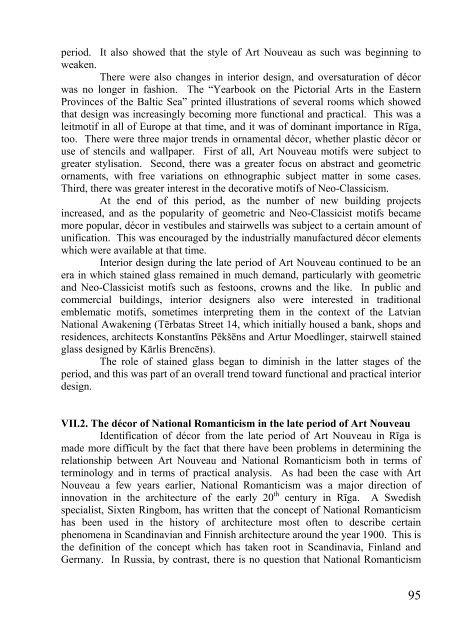SILVIJA GROSA JŪGENDSTILA PERIODA PLASTISKAIS UN ...
SILVIJA GROSA JŪGENDSTILA PERIODA PLASTISKAIS UN ...
SILVIJA GROSA JŪGENDSTILA PERIODA PLASTISKAIS UN ...
Create successful ePaper yourself
Turn your PDF publications into a flip-book with our unique Google optimized e-Paper software.
period. It also showed that the style of Art Nouveau as such was beginning to<br />
weaken.<br />
There were also changes in interior design, and oversaturation of décor<br />
was no longer in fashion. The “Yearbook on the Pictorial Arts in the Eastern<br />
Provinces of the Baltic Sea” printed illustrations of several rooms which showed<br />
that design was increasingly becoming more functional and practical. This was a<br />
leitmotif in all of Europe at that time, and it was of dominant importance in Rīga,<br />
too. There were three major trends in ornamental décor, whether plastic décor or<br />
use of stencils and wallpaper. First of all, Art Nouveau motifs were subject to<br />
greater stylisation. Second, there was a greater focus on abstract and geometric<br />
ornaments, with free variations on ethnographic subject matter in some cases.<br />
Third, there was greater interest in the decorative motifs of Neo-Classicism.<br />
At the end of this period, as the number of new building projects<br />
increased, and as the popularity of geometric and Neo-Classicist motifs became<br />
more popular, décor in vestibules and stairwells was subject to a certain amount of<br />
unification. This was encouraged by the industrially manufactured décor elements<br />
which were available at that time.<br />
Interior design during the late period of Art Nouveau continued to be an<br />
era in which stained glass remained in much demand, particularly with geometric<br />
and Neo-Classicist motifs such as festoons, crowns and the like. In public and<br />
commercial buildings, interior designers also were interested in traditional<br />
emblematic motifs, sometimes interpreting them in the context of the Latvian<br />
National Awakening (Tērbatas Street 14, which initially housed a bank, shops and<br />
residences, architects Konstantīns Pēkšēns and Artur Moedlinger, stairwell stained<br />
glass designed by Kārlis Brencēns).<br />
The role of stained glass began to diminish in the latter stages of the<br />
period, and this was part of an overall trend toward functional and practical interior<br />
design.<br />
VII.2. The décor of National Romanticism in the late period of Art Nouveau<br />
Identification of décor from the late period of Art Nouveau in Rīga is<br />
made more difficult by the fact that there have been problems in determining the<br />
relationship between Art Nouveau and National Romanticism both in terms of<br />
terminology and in terms of practical analysis. As had been the case with Art<br />
Nouveau a few years earlier, National Romanticism was a major direction of<br />
innovation in the architecture of the early 20 th century in Rīga. A Swedish<br />
specialist, Sixten Ringbom, has written that the concept of National Romanticism<br />
has been used in the history of architecture most often to describe certain<br />
phenomena in Scandinavian and Finnish architecture around the year 1900. This is<br />
the definition of the concept which has taken root in Scandinavia, Finland and<br />
Germany. In Russia, by contrast, there is no question that National Romanticism<br />
95












